The rapture mobile parked in front of the Bowery Poetry Club. I wonder what they thought they’d find on the Bowery.
UPDATE: No rapture–back to work.
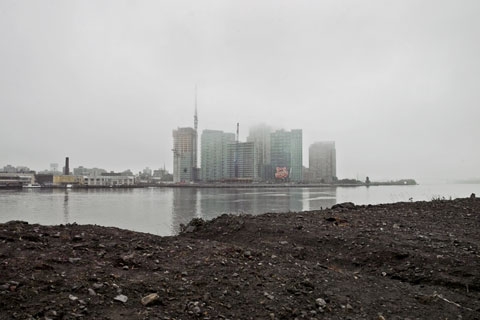
Long Island City from Roosevelt Island — © Brian Rose
On Sunday I took a tour of Four Freedoms Park, a memorial to Franklin Delano Roosevelt, currently under construction on Roosevelt Island. The island is located in the East River opposite Midtown and the Upper East Side. It is accessible by aerial tram and subway, and by a bridge from Queens. In the past, the island was primarily used for prisons and hospitals, a convenient location to keep separate from society certain people–notably the mentally ill, small pox patients, and victims of polio. In the 1970s a planned community of high rises was built for middle income residents, and more recently, market rate housing.
It was damp, foggy morning, and I joined about 25 other Cooper Union alumni for the hour-long tour at the far southern end of the island. The memorial was originally designed by Louis Kahn in 1973, but it was not built because of the city’s fiscal problems. The project was resurrected a few years ago and is now going forward using the Kahn design. I snapped pictures of the construction site as well as views across the East River and historic structures on the island.

FDR Four Freedoms Park under construction — © Brian Rose
The memorial culminates in a granite enclosed “room” at the southern tip of Roosevelt Island opening onto a vista of the river and the adjacent United Nations complex in Manhattan–enveloped in fog above.
The complete series of ten photographs can be seen here.
The park website is here.
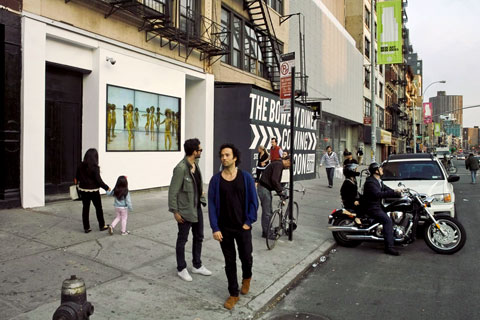
The Bowery at Stanton Street — © Brian Rose
Once again I found myself at the corner of Bowery and Stanton waiting for a taxi. I had a guitar slung over my shoulder and two bags, one full of groceries. I noticed that a group of people had gathered in front of the gallery video screen in the storefront of the old flophouse, the Sunshine Hotel. Gold painted figures dancing. During the day, the video screen is hard to see in the glare, but in the fading light of evening, it becomes relatively brighter. A last glint of sunlight touched the metallic skin of the New Museum just down the block.
A couple of months ago I did a similar photograph standing in the same spot–also waiting for a taxi–and my first thought was that there was no reason to repeat myself. But no cabs were coming, and I continued to watch the scene unfold. I put my bags down on the pavement and fumbled for my pocket camera. I could not move more than a step or two in any direction because my stuff was lying in the street. But I began to consider a shot that included the motorcycle parked to the right. People stopped briefly to watch the video, then scattered this way and that. A man and woman in helmets arrived and mounted the motorcycle. A man veered toward me and the composition coalesced around him.
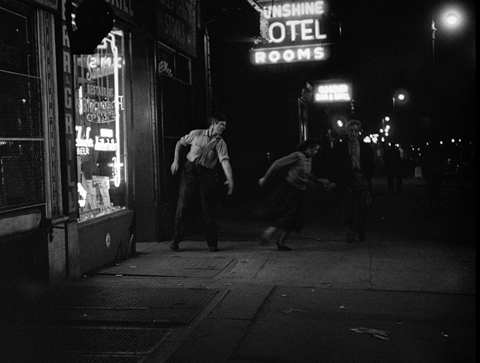
From On the Bowery, a film by Lionel Rogosin
I realized as I took the photograph that I was standing just a few feet to the right of the spot where Lionel Rogosin’s cameraman filmed the scene in On the Bowery where the drunken protagonist Ray Salyer slaps a woman and then stumbles up the stairs into the Sunshine Hotel, a Bowery survivor now surrounded by the most conspicuous of art consumption. On the Bowery is a remarkable film, half staged, half documentary, suggestive of much contemporary photography.
I wrote about the film here.
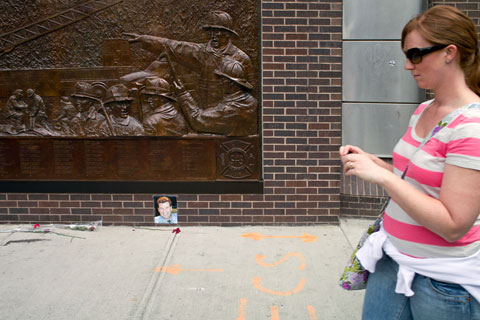
Fireman’s Memorial, Greenwich Street — © Brian Rose
The President was in New York last week in the wake of the killing of Osama bin Laden. He lunched with firemen from a company that lost men on 9/11 and greeted families of others who died at ground zero. I went downtown on Friday, a couple of days after Obama’s visit, to see how things were going. One World Trade Center appears now to be sixty or more stories high, and the above ground part of the 9/11 memorial and museum is being rushed to completion. Just a few months ago it was a steel skeleton–now it is mostly enclosed. I made several photographs with the view camera in the area just south of Liberty Street near the Fireman’s Memorial. I also snapped a few shots with my digital camera.
Tourists jammed the sidewalk near the Fireman’s Memorial, and possibly because of Obama’s recent visit, there were lots of flowers and pictures placed along the wall of the memorial. There were no such items the last few times I’d been there. A tour guide led a large group of out-of-towers by the memorial and I heard her refer to those “murdered” on 9/11. There was a thinly veiled anger conveyed by the use of the word murder. Yes, it’s true that those killed when the planes were crashed into the towers were, technically speaking, murdered in an act of violence. As are any victims of terrorism worldwide. And what about the innocent victims of unjustified wars? I’m not interested in a moral equivalency argument here. It’s clear enough what happened on 9/11. I just think it is better to tone down the rhetoric.
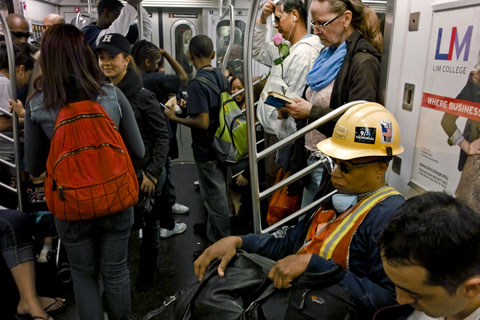
On the 6 train in Lower Manhattan — © Brian Rose
On the subway heading back uptown, I saw a construction worker from the World Trade Center site. His hardhat was decorated with stickers, one for the 9/11 memorial and an another with a flag and the Twin Towers.
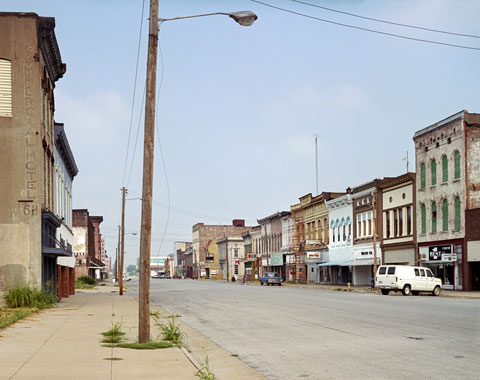
Commercial Street, Cairo, Illinois, 1989 (4×5 film) — © Brian Rose
With all the news about Osama bin Laden, less attention is being paid to an ongoing drama in the heartland of the U.S. The Mississippi and Ohio Rivers are running extremely high, threatening multiple locations, but especially the historic town of Cairo, Illinois. Cairo was once a bustling trading center at the confluence of the two rivers with its own custom house and 15,000 people. There were hotels, theaters, and fine mansions. As river transportation fell off, Cairo slipped into decline, which was exacerbated by racial segregation leading to riots in the ’60s, and wholesale white flight. Today, much of Cairo is a ghost town, its main street a ragged line of crumbling buildings interspersed with rubble strewn lots.
In 1989 I traveled with my view camera along the Ohio River from Pittsburgh to Cairo–another of my unfinished projects–due to lack of money. After two or three weeks of shooting, driving southwest along the river, I finally made it to Cairo having no idea what to expect. It was then, as now, a shocking tableau of abandonment.
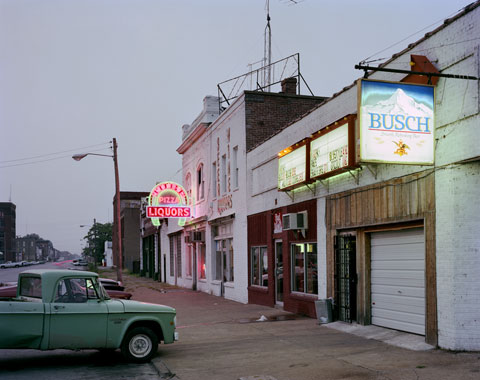
Commercial Street in 1989, Cairo, Illinois (4×5 film) — © Brian Rose
Along with the abandonment there was a palpable whiff of danger in the air, a few pick-up trucks pulled up at bars, solitary individuals drifting about with no apparent destination. Despite the menacing atmosphere I managed to take a few photographs as the sun went down, and then returned in the morning. Things were much less scary in broad daylight, but equally devoid of activity. As I wandered about with my camera I was approached by a middle aged who turned out to be the head of the chamber of commerce. The fact that an out of town photographer was interested in the place was reason enough for him to invite me to lunch at a nearby diner. He wanted to bring Cairo back–a middle-aged white man in a largely black city–but his blue-suited boosterism, seemed out of time and out of step in this scene of desolation.
That was in 1989–and almost nothing has changed in 22 years except that much of Cairo’s extraordinary architecture has further decayed or has disappeared altogether. In the intervening years some of the historic mansions have been preserved as has the old custom house. But the downtown remains spectral, made all the more so by fancy brick paving stones and retro lampposts on parts of Commercial Street, a superficial attempt at revitalization.
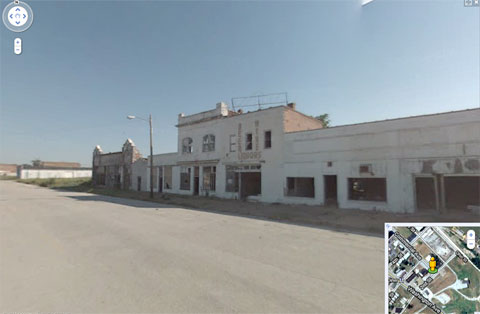
Google Street View of the same stretch of storefronts as above.
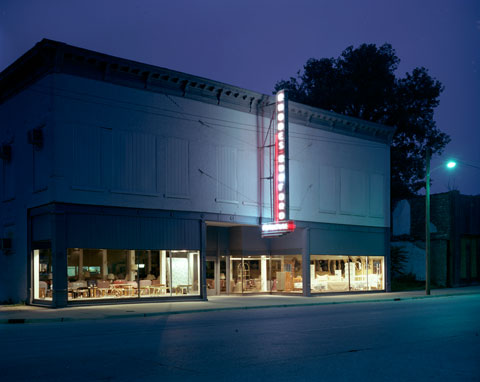
Commercial Street in 1989, Cairo, Illinois (4×5 film) — © Brian Rose
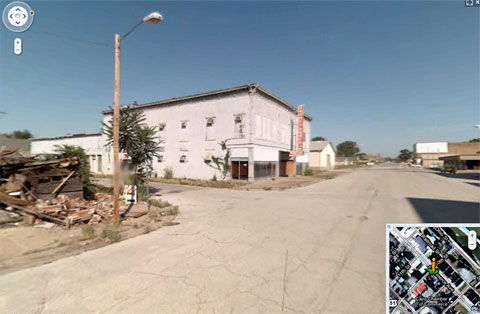
Google Street View of the same building as above.
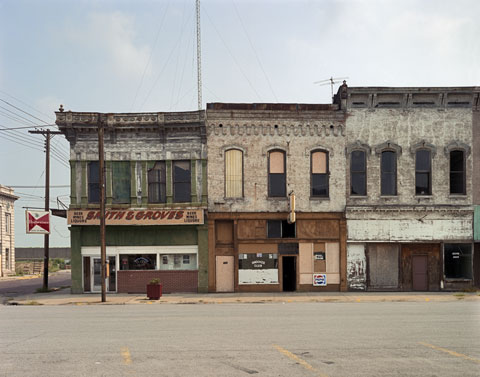
Commercial Street in 1989, Cairo, Illinois (4×5 film) — © Brian Rose
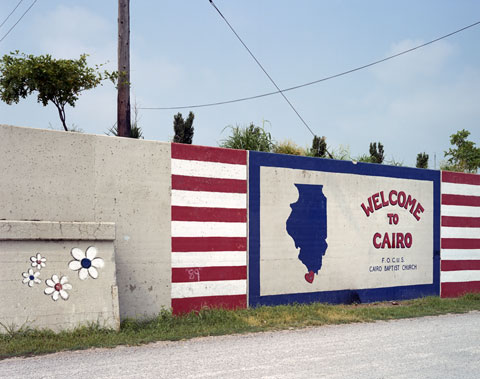
Ohio River levee in 1989, Cairo, Illinois (4×5 film) — © Brian Rose
The reality is that Cairo is a doomed city, a wedge of river sediment between the Ohio and Mississippi walled in by levees. A desperate fight is underway to save the city as the river water threatens to top the flood walls and ground water pressure builds underneath. The city’s 3,000 residents have been evacuated. Yesterday, the Army Corps of Engineers blasted an opening in a levee to the south flooding miles of fertile farmland to relieve the pressure. As of this morning, the levee breech seemed to be working, the water subsiding, but Cairo remains vulnerable. It may survive this season’s flood, but how long can a sandy spit of land withstand the uncontrollable force of two mighty rivers?
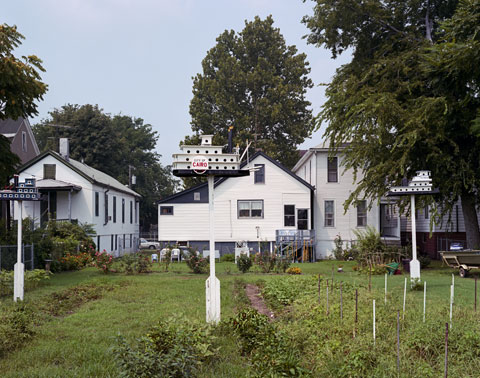
Cairo, Illinois in 1989 (4×5 film) — © Brian Rose
Birdhouses in the form of barge tows, a thematic reminder of why Cairo exists where it is. But the river transit that once made this a thriving small metropolis faded like the car industry faded in Detroit, another symbol of American decline. Or if not decline, then abject neglect, a too easy eagerness to shift attention to the next boom town, to the next swath of exurban frontier. Detroit may yet rise from the ashes, but Cairo sits betwixt and between, imprisoned by its history of racial strife and its impermanent geography.
In Mark Twain’s Adventures of Huckleberry Finn, Huck and the runaway slave Jim float down the big river on the lookout for Cairo, where the clear Ohio water meets the muddy Mississippi. Cairo is Jim’s gateway to the Ohio River and freedom, but they missed their landmark in the fog and drifted on south into slave territory.
There warn’t nothing to do now but to look out sharp for the town, and not pass it without seeing it. He said he’d be mighty sure to see it, because he’d be a free man the minute he seen it, but if he missed it he’d be in a slave country again and no more show for freedom. Every little while he jumps up and says:
“Dah she is?”
But it warn’t. It was Jack-o’-lanterns, or lightning bugs; so he set down again, and went to watching, same as before. Jim said it made him all over trembly and feverish to be so close to freedom.
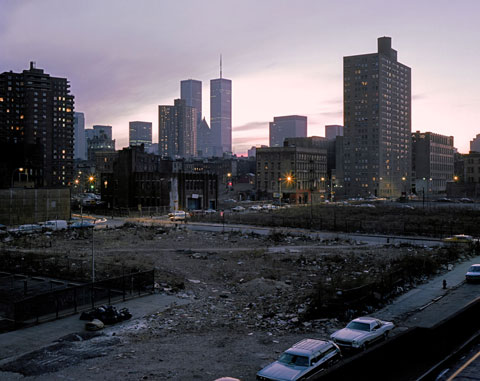
Twin Towers, 1980 (4×5 film) — © Brian Rose/Ed Fausty
Osama bin Laden killed in Pakistan. Nine years and seven months after 9/11.
Although I share a degree of the elation demonstrated by the crowds that gathered near the White House and at Times Square last night, I’ve lived long enough to know that these moments are all too fleeting. I remember well when the Berlin Wall opened–I was there a few weeks afterwards to photograph its rapid destruction. And I remember the feeling that the world had changed forever, that freedom had won out over authoritarianism. That the long shadow of World War II had finally been lifted off of central Europe.
Twelve years later, Osama bin Laden and his terrorist hit men flew airplanes into the World Trade Center and another shadow descended. September 11th, and our reaction to it, led to an unjustified war in Iraq, torture, and the weakening of our economy–call it Bin Laden’s decade-long victory. Feel free to argue otherwise, but I do not think history will support it. Bin Laden’s death does not end that saga, but it offers, at least symbolically, the possibility that we can move forward again, after falling back.
Undoubtedly, those who were directly touched by 9/11 will feel that justice has been served, though I doubt that closure is an appropriate word to describe their (our) ongoing loss. I think, especially, of my friend Jack Hardy, the songwriter, whose brother was killed in one of the towers. Jack died in March of cancer. Were he here today, I do not think he would find much solace in bin Laden’s demise.

Twin Towers facade montage — © Brian Rose
For me, it is a moment of mixed emotions. I have spent a good deal of my life as a photographer focused, by design or by accident, on these two watershed events, the fall of the Berlin Wall and the destruction of the World Trade Center. They are two of the most important events of our time. I have books on these subjects, whole bodies of work. With today’s news I have this rare sense of being momentarily at the center of things, that my work connects to the flow of history. And yet, just as quickly, I feel history rushing forward and slipping from my grasp.
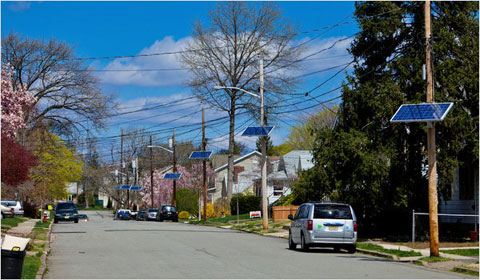
Fair Lawn, New Jersey — Juan Arredondo for The New York Times
I read with some amusement an article in the New York Times on New Jersey residents complaining about solar panels mounted on utility poles in their neighborhoods.
“I hate them,” Mr. Olsen, 40, said of the row of panels attached to electrical poles across the street. “It’s just an eyesore.”
Some residents consider the overhanging panels “ugly” and “hideous” and worry aloud about the effect on property values.
Yes, looking at the photograph above there clearly is a problem. The street is cluttered with old wooden poles festooned with transformer boxes and draped with telephone and electrical wires. The solar panels merely add to the visual cacophony. This is how residential streets look all over the country–and I am sorry to say that most people have become blind to it. Moreover, in the current political and economic climate there is little hope that this design cancer will be addressed.
Tassafaronga Village, Oakland, California (4×5 film) — © Brian Rose
Recently, I photographed Tassafaronga Village in Oakland, California for architect David Baker. It is comprised of low income and middle income housing. In the shot above I am looking over an undulating green roof toward townhouse apartments with solar panels mounted on stanchions and on the roofs. Utility lines are invisible–only the solar panels remain exposed. Imagine the street in New Jersey with a series of new appropriately designed poles mounted with solar panels. The panels would be plainly visible, of course, but the overall look greatly simplified. It could be done elegantly.
Tassafaronga Village, Oakland, California (4×5 film) — © Brian Rose
Here is another view of the project looking toward a larger apartment building containing community rooms and support offices. The previous view was shot from one of the narrow vertical windows on the second floor. Solar panels face south along the street.
As a society we are neglecting the public commons. Our communities are visually polluted with all kinds ill-considered utility structures, cheaply built municipal buildings, and unregulated strip developments. Present day political discourse is all about what we can’t do rather than what we can do.
New Jersey: require the utility companies to bury those lines.
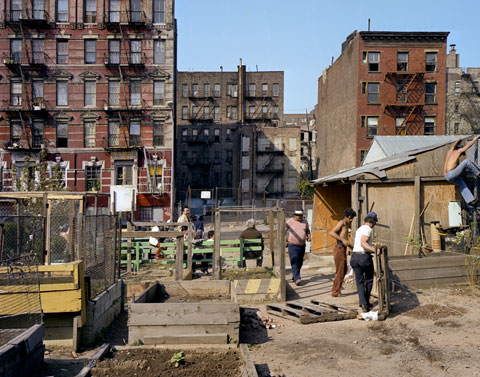
E12th Street, 1980 (4×5 film) — © Brian Rose/Ed Fausty
While working on a grant application having to do with urban farming and gardens I went back to my archive of unscanned Lower East Side photographs from 1980. I found one of a garden on E12th Street that I liked–taken on an early spring day it shows a number of people working. It’s interesting to note that the gardeners appear mostly Latino, which runs counter to my assumption that the urban gardening movement on the Lower East Side was largely a white middle class undertaking. This garden, by the way, still exists on E12th Street between Avenue A and B.
When I did my library slide talk a month ago, I was asked by someone in the audience how many photographs I had from 1980, suggesting that they should be preserved for the historical record–including pictures that were left out of the book. There are several hundred. I do think the entire project should be scanned, and eventually made available to the public.
My exhibition of 14 LES photographs is still up at the Lower East Side Visitor Center at 49 Orchard Street. The next exhibition there begins on May 14th, so I will leave my prints up for a couple more weeks. If anyone is interested in purchasing one or more of the mounted exhibition prints, please get in touch. I am offering them at a favorable price.
Have been working on another grant application–this time with the Design Trust for Public Space. They have commissioned photographers in the past to explore different aspects of the urban landscape. This year the theme is “five borough farm,” a project to survey and document urban agriculture around the city. The stipend is only $5,000, but one is also assured of an exhibition and publication. Just one photographer selected. I’d be perfect for this.
Last night I went to the Rattlestick Playwrights Theater in Greenwich Village to see Suzanne Vega perform her musical play “Carson McCullers Talks About Love.” Years ago, Suzanne worked up a monologue based on the character of the author Carson McCullers–one of several female personalities that she has been drawn to, or taken inspiration from. It was, at that time, a minor but affecting performance. She has now developed the idea into an ambitious portrayal of the writer with songs and music co-written with Duncan Sheik. The songs exhibit many of the familiar melodic and lyrical qualities of earlier Vega music; some are complete stand-alone songs; others are intended more to support the narrative of the play. At least that’s my take on hearing them for the first time.
Suzanne assumes the character of Carson McCullers, with whom she shares a striking resemblance. She walks on stage as herself, gives a short introduction, and then dons a wig and removes her makeup at a mirror to better resemble the tomboyish McCullers. Like her earlier McCullers performance, it is essentially a monologue, but now there is occasional verbal interplay with a pianist and guitarist who remain on stage throughout the play.
It is not necessary to have read Carson McCullers to appreciate the play, though it certainly doesn’t hurt to be familiar with her work and that of other mid-century American authors who she came in contact with, or compares herself to. One song, in fact, is full of boasts about how she, McCullers, is better than Harper Lee. Although there is sadness and tragedy in McCullers’ personal story, Vega portrays her with a good deal of feisty wit and bravado.
For Suzanne, doing this play is a labor of love, beautifully realized, bestowed upon the audience.

Williamsburg, Brooklyn — © Brian Rose
Without comment.
Update: I just read the shocking news that Tim Hetherington was killed in Libya covering the uprising against the Qaddafi government. I have written about Hetherington a couple of times, someone I hailed as expanding the concept of photojournalism with his still photography and video. Two other photographers, Chris Hondros and Guy Martin were seriously injured in the same incident.
Here is the New York Times article.
My post about Hetherington here.
Latest news is that Chris Hondros has died.
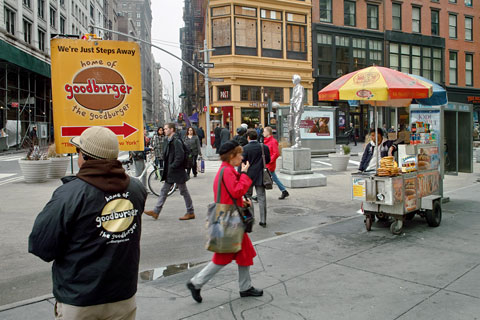
The Andy Monument, Broadway at Union Square Park — © Brian Rose
Union Square Park is home to some of the finest sculptures in New York City. These are mostly traditional likenesses of important historical figures like George Washington, Abraham Lincoln, Marquis De Lafayette, and Mahatma Gandhi. The Lafayette statue was made by Frédéric-Auguste Bartholdi (1834–1904), who also designed the Statue of Liberty in New York Harbor. Although the park is often associated with the labor movement because it has frequently been the location of parades and political rallies, the name comes from the “union” of two major streets, Broadway and the Bowery Road, now called 4th Avenue. In the days after the attack on the World Trade Center in 2001, Union Square, in the plaza surrounding the Washington equestrian sculpture, became the site of one of the largest spontaneous memorials in the city.
The area around the park has gone through many ups and downs over the years, but in the 1970s it was considerably less vibrant economically than today. I remember the park in the late 70s as one big open air drug bazar, and few people who lived and worked around Union Square stepped foot in it. As is often the case in New York, however, depressed circumstances create opportunities for others. Artists, ever nomadic, found the lofts around the park cheap and spacious. One of them was Andy Warhol, the Pop Art icon of the era. He and his “Factory” located on Union Square, became a nexus of art, fashion, music, and commerce.
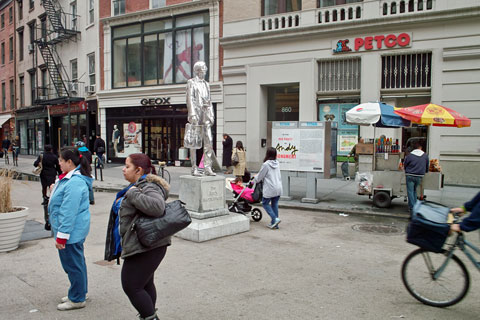
The Andy Monument, Broadway at Union Square Park — © Brian Rose
It is appropriate, therefore, that a statue be erected to the real and mythic Andy at the confluence of two of New York’s earliest and most important highways. As I came across the chrome Andy Monument the other day on a silvery gray day, the statue seemed almost ethereal in the mist and drizzle. Unlike the other bronze statues in Union Square, which express solidity and historical weight, Andy floats vaguely, aloofly, above the throngs of shoppers and office workers passing by.
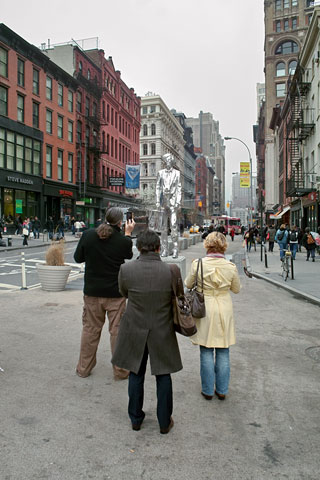
The Andy Monument, Broadway at Union Square Park — © Brian Rose
The sculpture is by Rob Pruitt and is sponsored by the Public Art Fund. Pruitt says:
Like so many other artists and performers and people who don’t fit in because they’re gay or otherwise different, Andy moved here to become who he was, to fulfill his dreams and make it big. He still represents that courage and that possibility. That’s why I came to New York, and that’s what my Andy Monument is about.
I took pictures for about five minutes. Most people walked on past, of course, but many stopped to make snapshots or read the adjacent text. It’s rare for a public sculpture to engage the public (fancy that) as much as this one does. Too bad that it is here only until October.
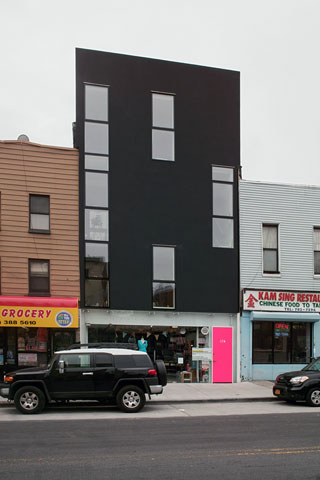
Grand Street, Williamsburg, Brooklyn — © Brian Rose
A new building from local firm Loading Dock 5. Despite the many mega housing projects in Williamsburg, the best architecture is often found in small infill projects like this one. The windows echo the off-the-shelf frames of the two aluminum sided houses on either side. A glimpse of the light filled interior can be seen through the tall vertical window.
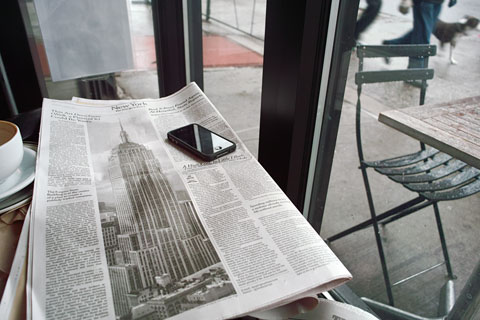
Cafe on the Bowery — © Brian Rose
An article about the Empire State Building, built during the Great Depression, it was once referred to as the Empty State Building because of the high vacancy rate. Nice to see an architectural view used so prominently in the paper. It looks a lot better here graphically rendered in black and white than it does in color on the NYT website–wrong time of day and hazy looking.
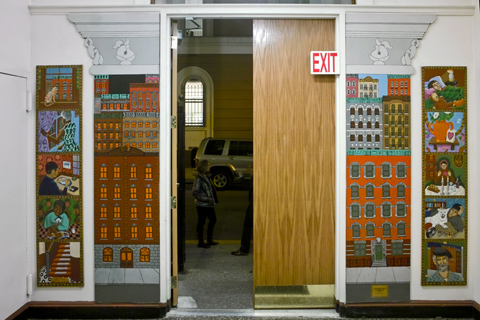
University Settlement, Eldridge Street — © Brian Rose
Saturday evening I went to the University Settlement for a slide presentation, which I thought was going to deal in part with the Lower East Side. It did begin with historic photographs of the neighborhood by important photographers like Jacob Riis and Berenice Abbott, but the contemporary work shown was from other places–four dyspeptic views of the dark side of American society–post Katrina New Orleans, foreclosure misery in Florida and Cleveland, Indian poverty at Pine Ridge, and a fashion show for women in prison. The program included Alan Chin, Brenda Ann Kenneally, Andrew Lichtenstein, and Anthony Suau.
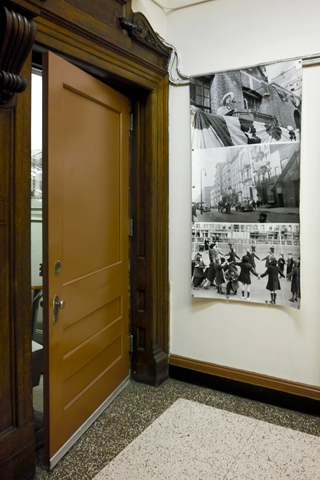
University Settlement — © Brian Rose
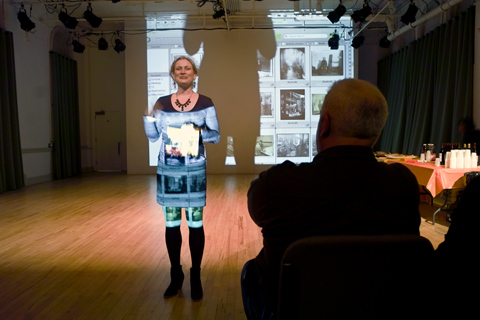
University Settlement slide presentation — © Brian Rose
One of the photographs shown by Anthony Suau depicts a Cleveland sheriff carrying out an eviction. It was the winner of the World Press Photo of the Year in 2008. One website compares this image to the famous Eddie Adams street execution photograph from Vietnam. The assumption is that warfare has come to the streets and homes of America. To me, the photograph is more ambiguous–a police officer stepping through a house strewn with trash, fearful that danger lies beyond the next door. We know it is an eviction, but we know little else of the circumstances. There are different possible scenarios. The larger issue of what led to foreclosures across the United States is the back story, not the immediate one of a fearful step forward by an officer with his gun drawn.
All of the subjects presented by the five photographers are serious, non trivial areas of inquiry, and I was impressed with the skill and commitment of the photographers, but ultimately I have grown so weary of this kind of you-are-there photojournalism that I can barely look at it any more. Surely this is the opposite of the reaction desired. The idea is to expose injustice and shock viewers into action. I am afraid that most people, like myself, tend to look away. The historical Lower East Side pictures were shown as inspiration and motivation for the slides to follow. The biggest difference between the older work and theirs is the difference between showing and telling. Modern photojournalism tends to more openly interpose the photographer between the story and the viewer.
That said, however, I don’t have a new paradigm of photojournalism to offer, and I am aware of the limitations of what I do, which is also a kind of photography that seeks to address social issues, if in a more round about manner. All I can say is that I am, and have been, searching for a way that is more inclusive and acknowledges the complexity of issues and the inherent difficulties in conveying visual meaning.
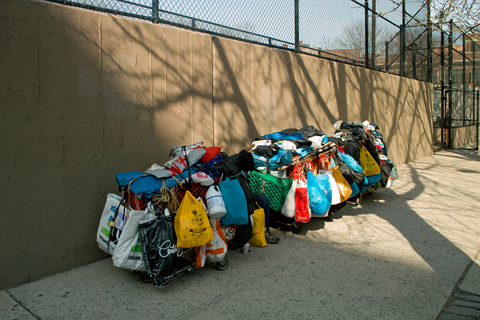
Clarkson Street, the West Village — © Brian Rose
In the photograph above–taken yesterday–there is a person just barely visible in the midst of the shopping carts and bags. What is the meaning or value of this kind of photograph? The sharp sun and shadows, the colorful plastic bags, the crazy incongruity. I do not expect every picture to answer the questions raised, but over the course of my work, I do hope that some threads of meaning become recognizable, some justification emerges, for what is inherently an exploitative enterprise.
Just before going to the University Settlement event I was pleased to meet Kristin Ellington of the multi-media firm Funny Garbage. We talked about the Lower East Side, my photographs, and her interest in creating a website dealing with the neighborhood, history and the present. I am looking forward to seeing her project take shape.